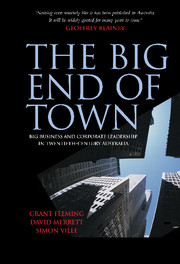Book contents
- Frontmatter
- Contents
- Preface
- 1 Introduction
- 2 The Development of Large-scale Enterprise in Australia
- 3 Identifying the Corporate Leaders
- 4 Paths of Corporate Development: Directions of Growth
- 5 Paths of Corporate Development: Methods of Growth
- 6 Financing Corporate Strategies
- 7 Organisational Configuration and Corporate Governance
- 8 Corporate Leaders, Big Business and the Economy
- Australian Standard Industrial Classification, 1969
- Abbreviations
- Appendix A
- Appendix B
- Notes
- Bibliography
- List of Tables and Figures
- Index
7 - Organisational Configuration and Corporate Governance
Published online by Cambridge University Press: 22 September 2009
- Frontmatter
- Contents
- Preface
- 1 Introduction
- 2 The Development of Large-scale Enterprise in Australia
- 3 Identifying the Corporate Leaders
- 4 Paths of Corporate Development: Directions of Growth
- 5 Paths of Corporate Development: Methods of Growth
- 6 Financing Corporate Strategies
- 7 Organisational Configuration and Corporate Governance
- 8 Corporate Leaders, Big Business and the Economy
- Australian Standard Industrial Classification, 1969
- Abbreviations
- Appendix A
- Appendix B
- Notes
- Bibliography
- List of Tables and Figures
- Index
Summary
Organisational configuration consists of the structures, processes, relationships and boundaries through which a company operates. They are influenced by the strategic options adopted by managers, the technological features of the company and its industry, the stage of life of the company, and its external environment. Thus, we have left the analysis of organisational configurations to the end of our study in order to examine the features of design and structure that are associated with longevity and big business.
Australian corporate leaders demonstrated many of the trends identified in studies of overseas developments in the corporate economy. Corporate leaders in several sectors invested in science-based technologies to exploit economies of scale, and expanded into products and markets through the use of multidivisional structures. We describe these developments in organisational configuration as companies developed core and related markets through horizontal and vertical integration.
Australian corporate leaders also faced unique geographical conditions that meant they had to deal with coordination problems and information flows over large distances if they wished to achieve national coverage. Pastoral agents, banks, retailers and property companies leveraged core competencies and replicated expertise across multiple sites, leading to an ‘organic’ multidivisional organisation. The size of the local market prevented companies from establishing scale in any other way.
Another point of differentiation from international experience was the position of multinational subsidiaries in providing demonstration effects to domestic firms.
- Type
- Chapter
- Information
- The Big End of TownBig Business and Corporate Leadership in Twentieth-Century Australia, pp. 161 - 201Publisher: Cambridge University PressPrint publication year: 2004



